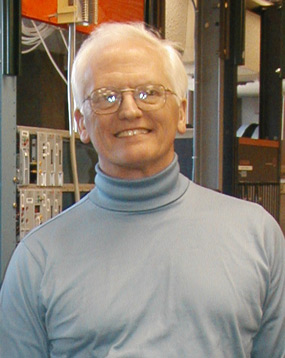| Getting the Calls Through |
||
| Contact: Celeste Kimbrough [ 412-624-1033; kimbro@pitt.edu ] | ||
Telecommunications company signs Pitt researchers to engineer a system that will augment the U.S. public telephone network
The system will link the public phone lines - Public Switched Telephone Network (PSTN) - with the Internet to create a telephone recovery system that can be deployed to subscribers within minutes of a disaster. A reliable, disaster-proof telecommunications technology could save billions of dollars by mitigating business losses. "If there has been a disaster, then chances are parts of the public telephone network wonıt be working, so we need to have alternate ways to put calls through," said Thompson, director of the Telecommunications Program in Pittıs School of Information Sciences (SIS) and professor in the Department of Information Sciences and Telecommunications. "Part of the project is to find the best way, through the public network or through the Internet, to reroute the calls." Thompson and five collaborators at Pitt will help engineer the system. Pittıs SIS building will host one of the four nodes, called a TeleContinuity Point of Presence (TPOP), of the initial prototype network. The TPOPs will interface between the Internet and PTSN and should be operational by the end of the year. "There will be more flexibility with this system," said Thompson. "It creates multiple ways to get calls through under a network that probably has missing pieces." Part of the system will be controlled by a modified Voice-over Internet Protocol (VoIP) that improves voice quality by minimizing call delay. The VoIPs use a technique created by Thompson and Boonchai Ngamwongwattana, a graduate student in the Telecommunications Program. TeleContinuity has obtained an exclusive license from the University for the use of this technology. In the event of a disaster, the system will reroute telephone traffic around network congestion and network failure points by a combination of path diversity, network diversity, and geographic dispersion. The technology will enable callers to reach subscribers by dialing their normal office phone numbers. Displaced executives and staff will be able to receive their office calls on any phone or personal computing device at any location and over any surviving network, as though no service disruption had occurred. "TeleContinuity is very pleased to be working with Thompson and the University of Pittsburgh on this vital national program," said Roy Pinchot, CEO of TeleContinuity. "Thompson and the Pitt telecommunications people were quick to grasp how TeleContinuityıs unique structure made its telecommunications system survivable even under extreme disaster situations. We look forward to working with Pitt to make Americaıs government and business telecommunications truly disaster-proof."
|
||

 PITTSBURGH -University of Pittsburgh researcher Richard
Thompson has been contracted by the Maryland-based company
TeleContinuity to engineer and implement a telecommunications
system that will support the U.S. public telephone network
during a disaster. Development is underway with support
from a $1.74 million grant from the National Institute
of Standards and
Technology.
PITTSBURGH -University of Pittsburgh researcher Richard
Thompson has been contracted by the Maryland-based company
TeleContinuity to engineer and implement a telecommunications
system that will support the U.S. public telephone network
during a disaster. Development is underway with support
from a $1.74 million grant from the National Institute
of Standards and
Technology.